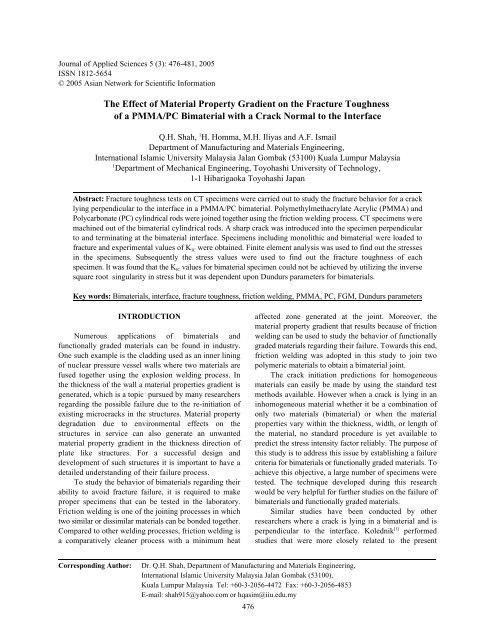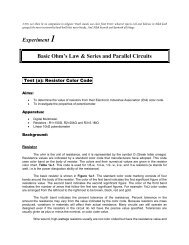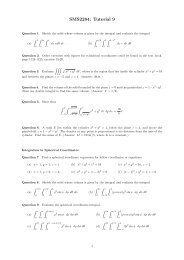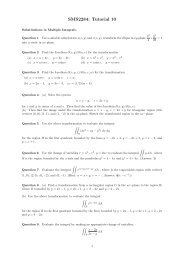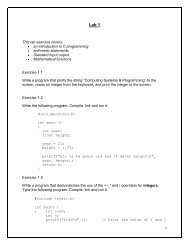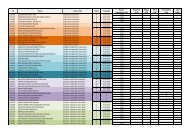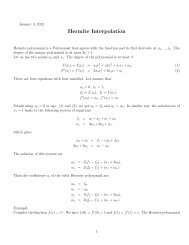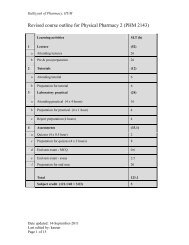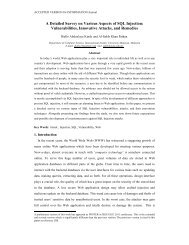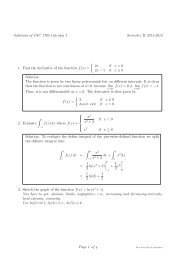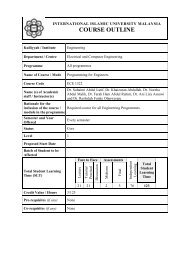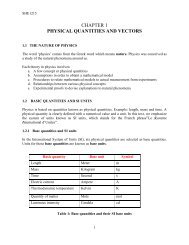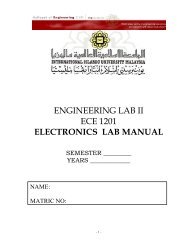The hardness gradient effect on the fracture toughness of bimateria
The hardness gradient effect on the fracture toughness of bimateria
The hardness gradient effect on the fracture toughness of bimateria
You also want an ePaper? Increase the reach of your titles
YUMPU automatically turns print PDFs into web optimized ePapers that Google loves.
Journal <strong>of</strong> Applied Sciences 5 (3): 476-481, 2005ISSN 1812-5654© 2005 Asian Network for Scientific Informati<strong>on</strong><str<strong>on</strong>g>The</str<strong>on</strong>g> Effect <strong>of</strong> Material Property Gradient <strong>on</strong> <strong>the</strong> Fracture Toughness<strong>of</strong> a PMMA/PC Bimaterial with a Crack Normal to <strong>the</strong> Interface1Q.H. Shah, H. Homma, M.H. Iliyas and A.F. IsmailDepartment <strong>of</strong> Manufacturing and Materials Engineering,Internati<strong>on</strong>al Islamic University Malaysia Jalan Gombak (53100) Kuala Lumpur Malaysia1Department <strong>of</strong> Mechanical Engineering, Toyohashi University <strong>of</strong> Technology,1-1 Hibarigaoka Toyohashi JapanAbstract: Fracture <strong>toughness</strong> tests <strong>on</strong> CT specimens were carried out to study <strong>the</strong> <strong>fracture</strong> behavior for a cracklying perpendicular to <strong>the</strong> interface in a PMMA/PC <strong>bimateria</strong>l. Polymethylmethacrylate Acrylic (PMMA) andPolycarb<strong>on</strong>ate (PC) cylindrical rods were joined toge<strong>the</strong>r using <strong>the</strong> fricti<strong>on</strong> welding process. CT specimens weremachined out <strong>of</strong> <strong>the</strong> <strong>bimateria</strong>l cylindrical rods. A sharp crack was introduced into <strong>the</strong> specimen perpendicularto and terminating at <strong>the</strong> <strong>bimateria</strong>l interface. Specimens including m<strong>on</strong>olithic and <strong>bimateria</strong>l were loaded to<strong>fracture</strong> and experimental values <strong>of</strong> K IC were obtained. Finite element analysis was used to find out <strong>the</strong> stressesin <strong>the</strong> specimens. Subsequently <strong>the</strong> stress values were used to find out <strong>the</strong> <strong>fracture</strong> <strong>toughness</strong> <strong>of</strong> eachspecimen. It was found that <strong>the</strong> K IC values for <strong>bimateria</strong>l specimen could not be achieved by utilizing <strong>the</strong> inversesquare root singularity in stress but it was dependent up<strong>on</strong> Dundurs parameters for <strong>bimateria</strong>ls.Key words: Bimaterials, interface, <strong>fracture</strong> <strong>toughness</strong>, fricti<strong>on</strong> welding, PMMA, PC, FGM, Dundurs parametersINTRODUCTIONaffected z<strong>on</strong>e generated at <strong>the</strong> joint. Moreover, <strong>the</strong>material property <str<strong>on</strong>g>gradient</str<strong>on</strong>g> that results because <strong>of</strong> fricti<strong>on</strong>Numerous applicati<strong>on</strong>s <strong>of</strong> <strong>bimateria</strong>ls and welding can be used to study <strong>the</strong> behavior <strong>of</strong> functi<strong>on</strong>allyfuncti<strong>on</strong>ally graded materials can be found in industry. graded materials regarding <strong>the</strong>ir failure. Towards this end,One such example is <strong>the</strong> cladding used as an inner lining fricti<strong>on</strong> welding was adopted in this study to join two<strong>of</strong> nuclear pressure vessel walls where two materials are polymeric materials to obtain a <strong>bimateria</strong>l joint.fused toge<strong>the</strong>r using <strong>the</strong> explosi<strong>on</strong> welding process. In <str<strong>on</strong>g>The</str<strong>on</strong>g> crack initiati<strong>on</strong> predicti<strong>on</strong>s for homogeneous<strong>the</strong> thickness <strong>of</strong> <strong>the</strong> wall a material properties <str<strong>on</strong>g>gradient</str<strong>on</strong>g> is materials can easily be made by using <strong>the</strong> standard testgenerated, which is a topic pursued by many researchers methods available. However when a crack is lying in anregarding <strong>the</strong> possible failure due to <strong>the</strong> re-initiati<strong>on</strong> <strong>of</strong> inhomogeneous material whe<strong>the</strong>r it be a combinati<strong>on</strong> <strong>of</strong>existing microcracks in <strong>the</strong> structures. Material property <strong>on</strong>ly two materials (<strong>bimateria</strong>l) or when <strong>the</strong> materialdegradati<strong>on</strong> due to envir<strong>on</strong>mental <str<strong>on</strong>g>effect</str<strong>on</strong>g>s <strong>on</strong> <strong>the</strong> properties vary within <strong>the</strong> thickness, width, or length <strong>of</strong>structures in service can also generate an unwanted <strong>the</strong> material, no standard procedure is yet available tomaterial property <str<strong>on</strong>g>gradient</str<strong>on</strong>g> in <strong>the</strong> thickness directi<strong>on</strong> <strong>of</strong> predict <strong>the</strong> stress intensity factor reliably. <str<strong>on</strong>g>The</str<strong>on</strong>g> purpose <strong>of</strong>plate like structures. For a successful design and this study is to address this issue by establishing a failuredevelopment <strong>of</strong> such structures it is important to have a criteria for <strong>bimateria</strong>ls or functi<strong>on</strong>ally graded materials. Todetailed understanding <strong>of</strong> <strong>the</strong>ir failure process.achieve this objective, a large number <strong>of</strong> specimens wereTo study <strong>the</strong> behavior <strong>of</strong> <strong>bimateria</strong>ls regarding <strong>the</strong>ir tested. <str<strong>on</strong>g>The</str<strong>on</strong>g> technique developed during this researchability to avoid <strong>fracture</strong> failure, it is required to make would be very helpful for fur<strong>the</strong>r studies <strong>on</strong> <strong>the</strong> failure <strong>of</strong>proper specimens that can be tested in <strong>the</strong> laboratory. <strong>bimateria</strong>ls and functi<strong>on</strong>ally graded materials.Fricti<strong>on</strong> welding is <strong>on</strong>e <strong>of</strong> <strong>the</strong> joining processes in which Similar studies have been c<strong>on</strong>ducted by o<strong>the</strong>rtwo similar or dissimilar materials can be b<strong>on</strong>ded toge<strong>the</strong>r. researchers where a crack is lying in a <strong>bimateria</strong>l and isCompared to o<strong>the</strong>r welding processes, fricti<strong>on</strong> welding is[1]perpendicular to <strong>the</strong> interface. Kolednik performeda comparatively cleaner process with a minimum heat studies that were more closely related to <strong>the</strong> presentCorresp<strong>on</strong>ding Author:Dr. Q.H. Shah, Department <strong>of</strong> Manufacturing and Materials Engineering,Internati<strong>on</strong>al Islamic University Malaysia Jalan Gombak (53100),Kuala Lumpur Malaysia Tel: +60-3-2056-4472 Fax: +60-3-2056-4853E-mail: shah915@yahoo.com or hqasim@iiu.edu.my476
J. Applied Sci., 5 (3): 476-481, 2005Fig. 5: Result <strong>of</strong> numerical calculati<strong>on</strong> for 8 (=0.85)<str<strong>on</strong>g>The</str<strong>on</strong>g> <strong>fracture</strong> <strong>toughness</strong> can be calculated usingequati<strong>on</strong> (1) for m<strong>on</strong>olithic materials while equati<strong>on</strong> (2)gives <strong>the</strong> correct results for <strong>bimateria</strong>ls and it is basedup<strong>on</strong> <strong>the</strong> Dundurs parameters proposed by Cook and[14]Erdogan . 8 was found to be 0.85 for <strong>the</strong> <strong>bimateria</strong>lstested in <strong>the</strong> present work.<str<strong>on</strong>g>The</str<strong>on</strong>g> material ahead <strong>of</strong> <strong>the</strong> crack tip plays an important roleto determine <strong>the</strong> <strong>fracture</strong> <strong>toughness</strong> <strong>of</strong> <strong>bimateria</strong>ls.Fracture <strong>toughness</strong> enhancement in <strong>bimateria</strong>lspecimen when <strong>the</strong> material ahead <strong>of</strong> <strong>the</strong> crack tip istougher is c<strong>on</strong>tributed by <strong>the</strong> higher <strong>toughness</strong> <strong>of</strong> <strong>the</strong>material ahead <strong>of</strong> <strong>the</strong> crack tip with an additi<strong>on</strong>al <str<strong>on</strong>g>effect</str<strong>on</strong>g> <strong>of</strong><strong>the</strong> interface c<strong>on</strong>straint.REFERENCESFig. 6: <str<strong>on</strong>g>The</str<strong>on</strong>g> <strong>fracture</strong> <strong>toughness</strong> values obtained fromstress values ahead <strong>of</strong> <strong>the</strong> crack tip. Fracture<strong>toughness</strong> <strong>of</strong> PMMA-PC (<strong>bimateria</strong>l) specimen isabout 3.52 MPa/m. PC-PMMA (<strong>bimateria</strong>l)<strong>fracture</strong> <strong>toughness</strong> is about 1.50 Mpa/mregi<strong>on</strong> where <strong>the</strong> m<strong>on</strong>olithic and <strong>bimateria</strong>l KIClines crosseach o<strong>the</strong>r and <strong>the</strong> <strong>bimateria</strong>l curve starts rising to <strong>the</strong> leftshows <strong>the</strong> true <strong>fracture</strong> <strong>toughness</strong> for <strong>the</strong> <strong>bimateria</strong>ls(at a distance <strong>of</strong> 0.206 mm from <strong>the</strong> crack tip). Whenobserving <strong>the</strong> stress values in Fig. 4, a regular variati<strong>on</strong>can be seen for all four cases but <strong>the</strong> <strong>fracture</strong> <strong>toughness</strong>results in Fig. 6 show a difference for <strong>the</strong> <strong>bimateria</strong>lsspecimen. <str<strong>on</strong>g>The</str<strong>on</strong>g> difference is not very significant due to <strong>the</strong>fact that <strong>the</strong> elastic modulii for <strong>the</strong> materials tested wereclose to each o<strong>the</strong>r. <str<strong>on</strong>g>The</str<strong>on</strong>g> observed change can beattributed to <strong>the</strong> <strong>fracture</strong> <strong>toughness</strong> formula used where1-8instead <strong>of</strong> r½ ,r values are used.CONCLUSIONSPMMA and PC materials were joined using fricti<strong>on</strong>welding process to manufacture <strong>the</strong> <strong>bimateria</strong>l CTspecimens. Fracture <strong>toughness</strong> tests <strong>on</strong> CT specimenswere made to study <strong>the</strong> crack initiati<strong>on</strong> <strong>fracture</strong> <strong>toughness</strong>for m<strong>on</strong>olithic and <strong>bimateria</strong>l specimens. Fracture<strong>toughness</strong> results from <strong>the</strong> experimental data werec<strong>on</strong>firmed using <strong>the</strong> stress values ahead <strong>of</strong> <strong>the</strong> crack tipobtained by finite element analysis.From <strong>the</strong> results <strong>of</strong> experimental work and numericalanalysis following c<strong>on</strong>clusi<strong>on</strong>s were made:1. Kolednik, O., 2000. <str<strong>on</strong>g>The</str<strong>on</strong>g> yield stress <str<strong>on</strong>g>gradient</str<strong>on</strong>g> <str<strong>on</strong>g>effect</str<strong>on</strong>g> ininhomogeneous materials. Intl. J. Solids andStructures, 37: 781-808.2. Kim, A.S., J. Bess<strong>on</strong> and A. Pineau, 1999. Global andlocal approaches to <strong>fracture</strong> normal to interfaces. Intl.J. Solids and Structures, 36: 1845-1864.3. Marur, P.R. and H.V. Tippur, 2000. Numerical analysis<strong>of</strong> crack tip fields in functi<strong>on</strong>ally graded materialswith a crack normal to <strong>the</strong> elastic <str<strong>on</strong>g>gradient</str<strong>on</strong>g>. Intl. J.Solids and Structures, 37: 5353-5370.4. Chang, J.H. and D.J. Wu, 2003. Calculati<strong>on</strong> <strong>of</strong> mixedmode stress intensity factors for a crack normal to a<strong>bimateria</strong>l interface using c<strong>on</strong>tour integrals.Engineering Fracture Mechanics, 70: 1675-1695.5. Simha, N.K., F.D. Fischer and O. Kolednik, 2003.Inhomogeneity <str<strong>on</strong>g>effect</str<strong>on</strong>g>s <strong>on</strong> <strong>the</strong> crack driving force inelastic and elastic-plastic materials. J. Mechanics andPhysics <strong>of</strong> Solids, 51: 209-240.6. Jiang, F., Z.L. Deng, K. Zhao and J. Sun, 2003.Fatigue crack propagati<strong>on</strong> normal to a plasticitymismatched <strong>bimateria</strong>l interface. Materials Scienceand Engineering, A00:1-9.7. Shah, Q.H. and H. Homma, 1995. Fracture criteri<strong>on</strong> <strong>of</strong><strong>the</strong> materials subjected to temperature <str<strong>on</strong>g>gradient</str<strong>on</strong>g>. Int.J. Pressure Vessels and Piping, 62: 59-68.8. Li, C. and Z. Zou, 1998. Stress intensity factors for afuncti<strong>on</strong>ally graded material cylinder with an externalcircumferential crack. Fatigue and Fracture <strong>of</strong>Engineering Materials and Structures, 21: 1447-1457.9. Lahiri, S., B.V. Sankar and P.A. Mataga, 1996.Evaluati<strong>on</strong> <strong>of</strong> <strong>bimateria</strong>l stress intensity factorsusing a finite element-boundary elementalternating method. Engineering Fracture Mechanics,53: 289-302.480
J. Applied Sci., 5 (3): 476-481, 200510. Kang, Y. and L. Hua, 2002. Investigati<strong>on</strong> <strong>of</strong> near-tip 14. Cook, T.S. and F. Erdogan, 1972. Stresses in b<strong>on</strong>deddisplacement fields <strong>of</strong> a crack normal to and materials with a crack perpendicular to <strong>the</strong> interface.terminating at a <strong>bimateria</strong>l interface under mixed Intl. J. Engineering Science, 10: 677-697.mode loading. Engineering Fracture Mechanics, 15. Zak, A.R. and M.L. Williams, 1963. Crack point stress69: 2199-2208. singularities at a <strong>bimateria</strong>l interface. J. Applied11. Chen, S.H., T.C. Wang and Shar<strong>on</strong> Kao-Walter, 2003. Mechanics-Transacti<strong>on</strong>s <strong>of</strong> <strong>the</strong> ASME, pp: 142-143.A crack perpendicular to <strong>the</strong> <strong>bimateria</strong>l interface in 16. Wang, T.C. and P. Stahle, 1998. Stress state in fr<strong>on</strong>tfinite solid. Intl. J. Solids and Structures, 40: 2731- <strong>of</strong> a crack perpendicular to <strong>bimateria</strong>l interface.2755. Engineering Fracture Mechanics, 59: 471-485.12. Chang, J.H. and J.D. Wu, 2003. Calculati<strong>on</strong>s <strong>of</strong> mixedmode stress intensity factor for a crack normal to a<strong>bimateria</strong>l interface using c<strong>on</strong>tour integrals.Engineering Fracture Mechanics, 70: 1675-1695.13. Alberto, R. and R. Ballarini, 1997. A cohesive z<strong>on</strong>emodel for cracks terminating at a <strong>bimateria</strong>l interface.Intl. J. Structures, 34: 1307-1326.481


